
Hematite, also spelled as haematite, is a common iron oxide compound with the formula, Fe2O3 and is widely found in rocks and soils. Hematite crystals belong to the rhombohedral lattice system which is designated the alpha polymorph of Fe
2O
3. It has the same crystal structure as corundum (Al
2O
3) and ilmenite (FeTiO
3). With this it forms a complete solid solution at temperatures above 950 °C (1,740 °F).

Magnetism is the class of physical attributes that occur through a magnetic field, which allows objects to attract or repel each other. Because both electric currents and magnetic moments of elementary particles give rise to a magnetic field, magnetism is one of two aspects of electromagnetism.
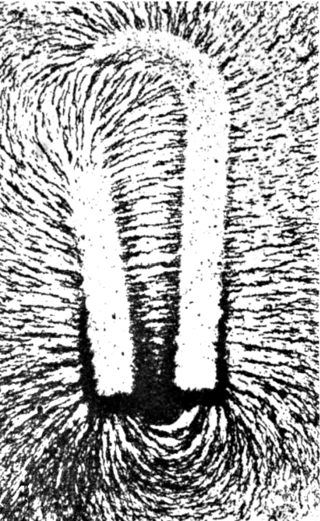
A magnetic field is a vector field that describes the magnetic influence on moving electric charges, electric currents, and magnetic materials. A moving charge in a magnetic field experiences a force perpendicular to its own velocity and to the magnetic field. A permanent magnet's magnetic field pulls on ferromagnetic materials such as iron, and attracts or repels other magnets. In addition, a nonuniform magnetic field exerts minuscule forces on "nonmagnetic" materials by three other magnetic effects: paramagnetism, diamagnetism, and antiferromagnetism, although these forces are usually so small they can only be detected by laboratory equipment. Magnetic fields surround magnetized materials, electric currents, and electric fields varying in time. Since both strength and direction of a magnetic field may vary with location, it is described mathematically by a function assigning a vector to each point of space, called a vector field.

Arachne is the protagonist of a tale in Greek mythology known primarily from the version told by the Roman poet Ovid (43 BCE–17 CE), which is the earliest extant source for the story. In Book Six of his epic poem Metamorphoses, Ovid recounts how the talented mortal Arachne challenged the goddess Athena to a weaving contest. When Athena could find no flaws in the tapestry Arachne had woven for the contest, the goddess became enraged and beat the girl with her shuttle. After Arachne hanged herself out of shame, she was transformed into a spider. The myth both provides an aetiology of spiders' web-spinning abilities and was a cautionary tale about hubris.

A magnet is a material or object that produces a magnetic field. This magnetic field is invisible but is responsible for the most notable property of a magnet: a force that pulls on other ferromagnetic materials, such as iron, steel, nickel, cobalt, etc. and attracts or repels other magnets.

Limonite is an iron ore consisting of a mixture of hydrated iron(III) oxide-hydroxides in varying composition. The generic formula is frequently written as FeO(OH)·nH2O, although this is not entirely accurate as the ratio of oxide to hydroxide can vary quite widely. Limonite is one of the three principal iron ores, the others being hematite and magnetite, and has been mined for the production of iron since at least 2500 BP.

Lodestones are naturally magnetized pieces of the mineral magnetite. They are naturally occurring magnets, which can attract iron. The property of magnetism was first discovered in antiquity through lodestones. Pieces of lodestone, suspended so they could turn, were the first magnetic compasses, and their importance to early navigation is indicated by the name lodestone, which in Middle English means "course stone" or "leading stone", from the now-obsolete meaning of lode as "journey, way".
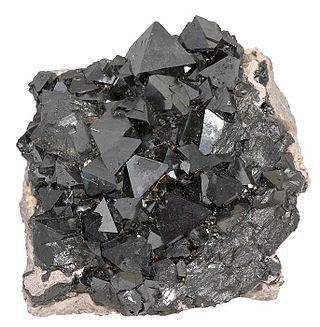
Magnetite is a mineral and one of the main iron ores, with the chemical formula Fe2+Fe3+2O4. It is one of the oxides of iron, and is ferrimagnetic; it is attracted to a magnet and can be magnetized to become a permanent magnet itself. With the exception of extremely rare native iron deposits, it is the most magnetic of all the naturally occurring minerals on Earth. Naturally magnetized pieces of magnetite, called lodestone, will attract small pieces of iron, which is how ancient peoples first discovered the property of magnetism.
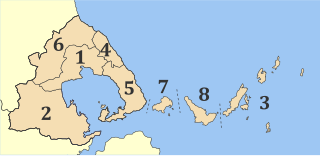
Magnesia is one of the regional units of Greece. It is part of the region of Thessaly. Its capital is the city of Volos. About 70% of the population of Magnesia live in the Greater Volos area, which is the second-largest city in Thessaly and the third busiest commercial port in Greece.

Magnesia or Magnesia on the Maeander was an ancient Greek city in Ionia, considerable in size, at an important location commercially and strategically in the triangle of Priene, Ephesus and Tralles. The city was named Magnesia, after the Magnetes from Thessaly who settled the area along with some Cretans. It was later called "on the Meander" to distinguish it from the nearby Lydian city Magnesia ad Sipylum. It was earlier the site of Leucophrys mentioned by several ancient writers.
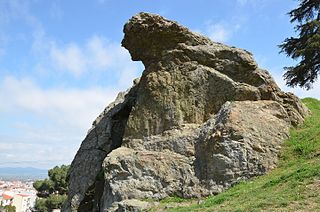
Mount Spil, the ancient Mount Sipylus, is a mountain rich in legends and history in Manisa Province, Turkey, in what used to be the heartland of the Lydians and what is now Turkey's Aegean Region.

De Magnete, Magneticisque Corporibus, et de Magno Magnete Tellure is a scientific work published in 1600 by the English physician and scientist William Gilbert. A highly influential and successful book, it exerted an immediate influence on many contemporary writers, including Francis Godwin and Mark Ridley.
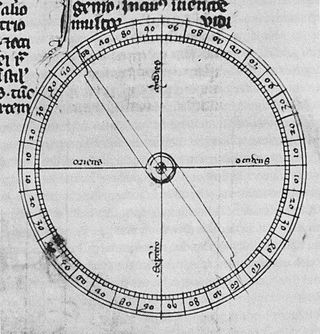
Petrus Peregrinus de Maricourt (Latin), Pierre Pelerin de Maricourt (French), or Peter Peregrinus of Maricourt, was a French mathematician, physicist, and writer who conducted experiments on magnetism and wrote the first extant treatise describing the properties of magnets. His work is particularly noted for containing the earliest detailed discussion of freely pivoting compass needles, a fundamental component of the dry compass soon to appear in medieval navigation. He also wrote a treatise on the construction and use of a universal astrolabe.

The Chera dynasty, was a Sangam age dynasty who unified various regions of the western coast and western ghats in southern India to form the early Chera empire.

Gangaridai is a term used by the ancient Greco-Roman writers to describe a people or a geographical region of the ancient Indian subcontinent. Some of these writers state that Alexander the Great withdrew from the Indian subcontinent because of the strong war elephant force of the Gangaridai.

In the ancient Mediterranean world, the classical compass winds were names for the points of geographic direction and orientation, in association with the winds as conceived of by the ancient Greeks and Romans. Ancient wind roses typically had twelve winds and thus twelve points of orientation, sometimes reduced to eight or increased to twenty-four.

The history of geomagnetism is concerned with the history of the study of Earth's magnetic field. It encompasses the history of navigation using compasses, studies of the prehistoric magnetic field, and applications to plate tectonics.
Marpessos was a settlement in the middle Skamander valley of the Troad region of Anatolia. The settlement's name is also spelled Μαρμησσός, Μαρμισσός, Μερμησσός in ancient sources. It was known in Classical antiquity primarily as the birthplace of the Hellespontine Sibyl Herophile. Its site has been located at Dam Dere approximately 2 km SE of the village of Zerdalilik in the Bayramiç district of Çanakkale Province in Turkey. Despite the similarity of its name and its location on Mount Ida, the settlement is apparently unrelated to the mythological figure Marpessa and her husband Idas. It should likewise not be confused with the Mount Marpessa on Paros.

Magnes sive de Arte Magnetica is a 1641 work by the Jesuit scholar Athanasius Kircher. It was dedicated to Emperor Ferdinand III and printed in Rome by Hermann Scheuss. It developed the ideas set out in his earlier Ars Magnesia and argued that the universe is governed by universal physical forces of attraction and repulsion. These were, as described in the motto in the book's first illustration, 'hidden nodes' of connection. The force that drew things together in the physical world was, he argued, the same force that drew people's souls towards God. The work is divided into three books: 1.De natura et facultatibus magnetis, 2.Magnes applicatus, 3.Mundus sive catena magnetica. It is noted for the first use of the term 'electromagnetism'.
Phalanx is a minor Attic figure in Greek mythology who features in a lesser-known narrative of the myth of Arachne, the girl who enraged the goddess Athena by boasting of being a better weaver than her and was thus transformed into a spider by Athena. In this version of the story, Phalanx is Arachne's brother, and they are both punished by the goddess when they break a societal taboo.


















